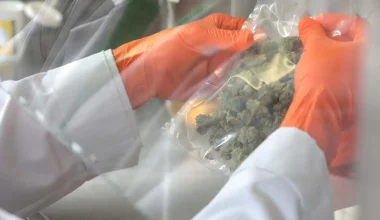
(This is a contributed guest column. To be considered as an MJBizDaily guest columnist, please submit your request here.)
The recent federal push to ban or severely limit hemp-derived THC products is the latest chapter in a regulatory saga rooted more in confusion than consumer safety.
But while the stated intent of protecting public health is laudable, the consequences of a sweeping ban could be disastrous.
Last week, Congress tucked into a funding bill signed into law by President Donald Trump language that renders most hemp-derived cannabinoid products – including delta-8 THC and THCA and – illegal after a one-year grace period.
The hemp THC ban extends not only to synthetically manufactured cannabinoids but also require that finished hemp-derived cannabinoid products contain no more than 0.4 mg of total THC per container,.
That’s a virtually impossible standard for many on-market products, including non-intoxicating CBD-rich concoctions.
Legitimate concerns over hemp THC, but ban will have unintended consequences
There is good reason to be concerned over hemp.
The legacy of the 2018 Farm Bill left a regulatory gap. By legalizing “hemp” but failing to regulate, Congress inadvertently allowed a parallel cannabis market for “intoxicating hemp” products to be sold via smoke shops, gas stations and over the internet with little of the oversight applied to state-regulated marijuana.
Law enforcement and regulators point to the risk of products that appeal to youth, lack child-resistant packaging and marketed without adequate dosing information. But what will the likely outcome be?
The hemp THC ban is forecast to wipe out up to 95 % of the existing U.S. hemp-derived cannabinoid market, eliminate 300,000-plus jobs, and cost states over $1.5 billion in tax revenue.
Worse: bans rarely eliminate demand. They simply push those demand streams underground, to unregulated markets with fewer safety safeguards and little consumer education.
As someone working in the “education-and-wellness” side of the cannabis industry, I would argue that this moment is not a call to eradicate hemp-derived THC but to educate it. An education-first approach would better align with public health goals, consumer welfare, and sustainable business models.
Here’s why.
Consumers remain confused, not malicious
Many adult consumers approach cannabis for wellness, relief, creative activity or moderate recreation but are overwhelmed by labeling that emphasizes strain names, THC percentages, or obscure cannabinoid abbreviations.
They often don’t know what “delta-8” vs “delta-9” means, nor how onset, dose or terpene profile might influence experience. This confusion reduces confidence, drives over-consumption, or pushes users back to illicit sources.
An education-based retail system shifts the narrative from “just get high” to “get informed and aligned with your goal.”
Label clarity and dosage guidance matter
When products carry transparent, plain-language information like verified lab data, terpene and cannabinoid profiles and expected onset/duration, consumers feel more confident, make safer choices, and retailers build trust and repeat users.
We have long known from behavioral decision-making theory that simpler, reliable information reduces cognitive overload and increases satisfaction and loyalty. (My recent research on consumer behavior in cannabis retail builds on this.)
The alternative is a landscape of mystery-boxes where consumers guess what happens next.
Regulation can incentivize innovation—not just restriction
Rather than outlawing all hemp-derived THC products, regulation frameworks can differentiate between product tiers (wellness-oriented, lifestyle-oriented, high-intensity), set potencies, require child-resistant packaging, age-gates, truthful marketing and ensure third-party lab testing.
This allows adult consumers to access diversified options while preserving safety. It also incentivizes entrepreneurs to innovate around functional, low-THC products rather than chasing the high-THC “edge” in a race of potency.
Jobs, tax revenue and responsible markets are at stake
In states where hemp-derived cannabinoids thrive, thousands of small businesses, farms, dispensary adjuncts and ancillary service providers depend on that sector. A blanket ban would devastate many of them.
Instead, an education-first, well-regulated approach supports job creation, keeps tax dollars in-state and helps build a robust regulated market that can compete with the illicit side.
In deep-red Texas, for example, Governor Greg Abbott vetoed a bill that would’ve banned THC-infused hemp products, citing the need for regulation rather than prohibition. And the state is moving forward with that plan despite Congress’s act.
Education builds public trust and policy goodwill
When regulators see a market that is transparent, consumer-safe and responsible, they are more likely to collaborate rather than clamp down. Conversely, when markets are opaque, the temptation is to respond with bans.
By proactively embedding consumer literacy, point-of-sale education, budtender certification and effect-based product categorization, the industry can elevate its credibility and reduce regulatory backlash.
Putting this into practice would look something like our “Experience Framework” model. It’s a clarity-first system that categorizes cannabis products not by strain or THC alone, but by intended experience:
- Wellness (<10% THC): gentle, restorative, body-balance support.
- Lifestyle (10–20% THC): functional, social, creative flow.
- Recreational (>20% THC): elevated, higher-intensity experiences for seasoned users.
When paired with point-of-sale data sheets translating lab results, terpene profiles and dosing guidance into plain language, and when retail staff receive certified training in responsible consumer communication, you get a retail experience that doesn’t just sell. It educates.
In Rhode Island, we are piloting this model in partnership with a local retailer, aiming to prove measurable impact on consumer clarity, repeat visits and safe use.
The same approach can and should be scaled nationally. It addresses both consumer welfare and regulatory demands without resorting to bans that undermine industry, innovation and tax revenue.
Redirecting the conversation from bans to bridges
The current wave of legislation aimed at banning hemp-derived THC products is a signal: regulators are alarmed. Yet alarm is not a strategy. We must shift from prohibition posture to a consumer-education posture. We need smart regulation, not blunt instrument bans.
If the future of cannabis is to be about choice, wellness, empowerment and consumer literacy, then the market must step up. Industry stakeholders brands, retailers, educators, policy advisors must prioritize transparent education, responsible product design, and alignment with consumer goals.
When consumers understand what they’re using, why it works, and how to use it safely, we reduce risk, build trust and increase value for individuals, for business and for society.
A ban might suppress supply, but education cultivates confidence. And confidence is what drives a truly sustainable cannabis market.
The question now is: will the industry help regulators by providing the bridge instead of fueling the wave of bans?
Dr. Magnus Thorsson is a professor of Cannabis Studies at Johnson & Wales University and Founder of Canna Curious Wellness, a Rhode Island based education company advancing consumer safety, cannabis literacy, and responsible retail training.
Medical Disclaimer:
The information provided in these blog posts is intended for general informational and educational purposes only. It is not a substitute for professional medical advice, diagnosis, or treatment. Always seek the advice of your physician or other qualified healthcare provider with any questions you may have regarding a medical condition. The use of any information provided in these blog posts is solely at your own risk. The authors and the website do not recommend or endorse any specific products, treatments, or procedures mentioned. Reliance on any information in these blog posts is solely at your own discretion.






